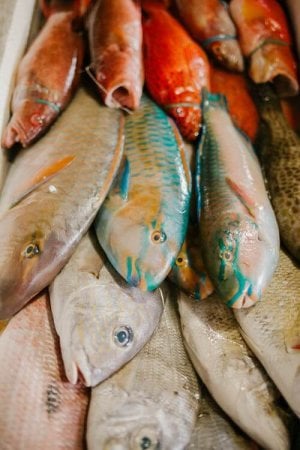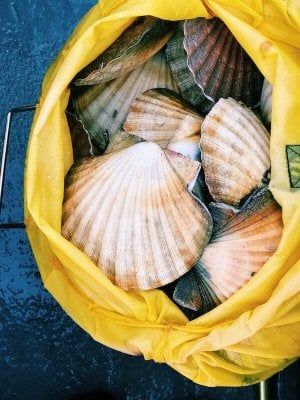Learn how to spot fresh seafood with these handy tips!
- Replies 2
Nothing says summer for Aussies like enjoying seafood, especially around the holidays, right?
But as we all know, seafood is one of the more sensitive foods to handle.
Any change in temperature or improper handling and before you know it, it’s no longer fit to eat.
Or you could also end up eating bad seafood and find yourself with a very upset stomach.
How do we avoid these two summertime nightmare scenarios?
Luckily for us, Sydney Fish Market Culinary Ambassador Sean Connolly has given out some handy tips to ensure the seafood we eat is nothing short of fresh.
Without further ado…
Use your senses

The first tip from Chef Sean is to use your eyes, nose and hands when browsing for seafood to take home.
Generally, he says shiny and lustrous-looking skin or scales is a good sign of freshness.
The flesh should be intact with no visible tears or marks, with the gills of fishes coloured bright pink-red.
Shellfish like oysters and mussels should have closed shells, or in cases they’re open, their shells should close when tapped.
Stale seafood is usually less vibrant in colour, and the flesh is less firm and almost mushy.
Now, when it comes to the smell, it can be quite tricky. Seafood already has that signature smell, so how do you use your nose to tell if seafood is fresh?
Chef Sean says the scent should be a ‘pleasant, fresh sea smell’ reminiscent of brine, as opposed to stale seafood’s dense, cloying, and sometimes rotten-smelling fishy aroma.
The smell is one good marker to tell if crabs, lobsters, and crayfish are fresh. If you notice strong odours coming from them while shopping, it might be best to move on.
As a rule of thumb, if seafood smells or looks even slightly off for you: ditch it!
Ice it, fast!
One golden rule to remember with seafood according to Chef Sean: every hour it’s not iced, a day is taken off its shelf-life.
He stresses this is something they practise religiously at the Sydney Fish Market, and not without reason.
Bacteria that causes foodborne illness can grow quickly on seafood and other perishable food items at 40 degrees Celsius, according to the US Food and Drug Administration.
The US FDA also recommends never leaving out seafood for more than 2 hours or less in warmer areas because of this fact.
Once you’ve selected your seafood item, Chef Sean says it would be best to place the item in an esky or cooler bag to ensure it stays as fresh as possible before you take it home. If possible, ask for assistance with ice for packing your seafood!
Store it properly

Once you’ve brought your seafood home, Chef Sean stresses it should be stored properly in a lidded container.
The container should be covered with a damp cloth and then covered by plastic wrap and/or another lid.
Manettas Seafood Market also recommends the same. In addition, they advise never to let seafood sit in its juices, and to place stored seafood in the coldest part of the fridge at 0-4 degrees Celsius.
If you want to take things a step further by freezing seafood, by all means, do it!
Chef Sean says there’s nothing wrong with it, and only to make sure the items are stored in an airtight freezer bag.

Now, if you’re on the lookout for a good seafood recipe, be sure to check out our Recipes & Cooking thread.
For example, you might like these tips for perfect seafood dishes straight from a celebrity chef, or this delicious pasta recipe that can accommodate any seafood you like.
So, what can you say about these tips from Chef Sean? Do you have any other pointers to add?
Tell us in the comments section below!
Source: YouTube/Sydney Fish Market
But as we all know, seafood is one of the more sensitive foods to handle.
Any change in temperature or improper handling and before you know it, it’s no longer fit to eat.
Or you could also end up eating bad seafood and find yourself with a very upset stomach.
How do we avoid these two summertime nightmare scenarios?
Luckily for us, Sydney Fish Market Culinary Ambassador Sean Connolly has given out some handy tips to ensure the seafood we eat is nothing short of fresh.
Without further ado…
Use your senses

Look for firm flesh and bright pink-red gills in fishes to see if they’re fresh. Credit: Pexels/Julia Volk
The first tip from Chef Sean is to use your eyes, nose and hands when browsing for seafood to take home.
Generally, he says shiny and lustrous-looking skin or scales is a good sign of freshness.
The flesh should be intact with no visible tears or marks, with the gills of fishes coloured bright pink-red.
Shellfish like oysters and mussels should have closed shells, or in cases they’re open, their shells should close when tapped.
Stale seafood is usually less vibrant in colour, and the flesh is less firm and almost mushy.
Now, when it comes to the smell, it can be quite tricky. Seafood already has that signature smell, so how do you use your nose to tell if seafood is fresh?
Chef Sean says the scent should be a ‘pleasant, fresh sea smell’ reminiscent of brine, as opposed to stale seafood’s dense, cloying, and sometimes rotten-smelling fishy aroma.
The smell is one good marker to tell if crabs, lobsters, and crayfish are fresh. If you notice strong odours coming from them while shopping, it might be best to move on.
As a rule of thumb, if seafood smells or looks even slightly off for you: ditch it!
Ice it, fast!
One golden rule to remember with seafood according to Chef Sean: every hour it’s not iced, a day is taken off its shelf-life.
He stresses this is something they practise religiously at the Sydney Fish Market, and not without reason.
Bacteria that causes foodborne illness can grow quickly on seafood and other perishable food items at 40 degrees Celsius, according to the US Food and Drug Administration.
The US FDA also recommends never leaving out seafood for more than 2 hours or less in warmer areas because of this fact.
Once you’ve selected your seafood item, Chef Sean says it would be best to place the item in an esky or cooler bag to ensure it stays as fresh as possible before you take it home. If possible, ask for assistance with ice for packing your seafood!
Store it properly

Storing seafood properly is important if you want to keep it edible for an extended period. Credit: Pexels/Julie Aagaard
Once you’ve brought your seafood home, Chef Sean stresses it should be stored properly in a lidded container.
The container should be covered with a damp cloth and then covered by plastic wrap and/or another lid.
Manettas Seafood Market also recommends the same. In addition, they advise never to let seafood sit in its juices, and to place stored seafood in the coldest part of the fridge at 0-4 degrees Celsius.
If you want to take things a step further by freezing seafood, by all means, do it!
Chef Sean says there’s nothing wrong with it, and only to make sure the items are stored in an airtight freezer bag.
Key Takeaways
- Sydney Fish Market Culinary Ambassador Sean Connolly gave out some tips on how to spot fresh seafood just in time for the Aussie holidays.
- First, he said shoppers should use their senses well in choosing what seafood items to buy.
- Shoppers should also preferably have eskys or coolers with them to store seafood in a cool environment.
- Lastly, once home, shoppers should also properly store seafood items in airtight containers in fridges or freezers to maximise the edibility of the seafood.
For example, you might like these tips for perfect seafood dishes straight from a celebrity chef, or this delicious pasta recipe that can accommodate any seafood you like.
So, what can you say about these tips from Chef Sean? Do you have any other pointers to add?
Tell us in the comments section below!
Source: YouTube/Sydney Fish Market








